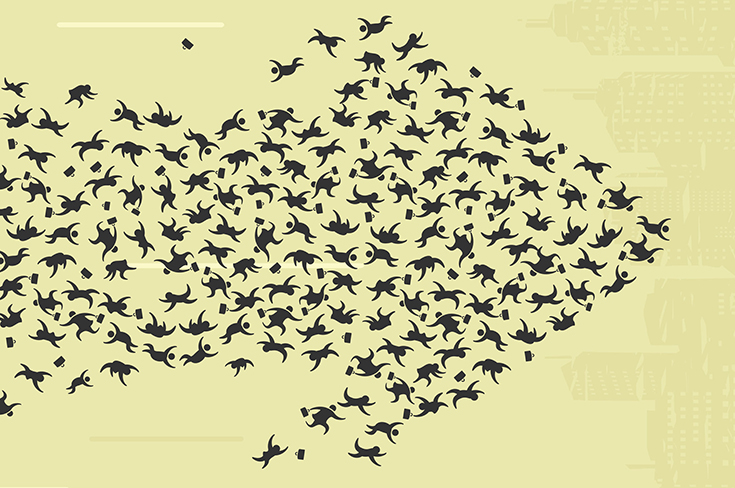Exploiting limbic reactions to protect crowds in emergencies
Editorial Advisory Panel Member Lina Kolesnikova suggests that perhaps the reactions of 'run', 'hide' and 'fight' could be harnessed to protect crowded places in emergencies.
In June 2017 a firecracker sparked panic in Turin's main square as 30,000 fans watched Juventus play a European Championship soccer match. The spectators thought the noise was an explosion. The crush that followed caused more than 1,500 injuries.

The main issue lies not in what triggers the situation, rather in how a group of people reacts to that trigger and metamorphoses into a crowd, and then in how that crowd behaves (Joe Bakal/123rf)
On September 15, an explosion occurred at Parsons Green station in London. Eighteen people were injured as a result of a bucket-bomb terrorist attack, but more casualties occurred owing to panic and stampede among passengers. This attack again raised the question about crowd control during an emergency situation.
At 16:38hrs on Friday, November 24, police started to receive numerous 999 calls within a short space of time reporting shots fired in a number of locations on Oxford Street and at Oxford Circus underground station in London, UK. Shoppers were urged to take cover in nearby buildings and eyewitnesses reported ‘panic’ and ‘stampedes’ as shoppers fled the scene or took shelter in shops.
The first armed response vehicle was on the scene in less than one minute from receiving our first call. The Metropolitan Police said: “Officers working with colleagues from British Transport Police carried out an urgent search of the area. No casualties, evidence of any shots fired or any suspects were located by police.”
The incident was later reported to have been started by an altercation between two men in Oxford Circus Underground Station.
During all terrorist incidents, security and rescue professionals are confronted by the issue of crowd control. I have received many questions about this problem myself and one of the most frequent ones is about educating people on emergency and situational awareness; in essence, ‘crowd education’.
One can inform and educate the public and society in general. But you cannot educate a crowd; we have to be realistic – it is too late to educate people in the midst of a terrorist attack.
A crowd is usually composed of a large group of strangers, often a mixture of people from different national, ethnic and cultural groups, sometimes with no language in common. Of course panic is a problem, but the consequences of panic – stampedes, trampling and suffocation – could result in real disaster.
There is a way forward in studying crowd control and in training organisers and crowd marshals. Some technical aspects can be learnt from those who already have extensive experience on crowd control, including: Special police units that deal with riots and violent protests; organisers of sport events and mass performances; and crew members on cruise lines. Whenever possible and depending on the threat, crowd dispersal can be an effective approach, among other methods.
But we should go beyond taking the situation at its face value. The main point to remember is that a terrorist attack (or another unexpected event, or even just a noise) MAY create a crowd; the crowd MAY then create a disaster.
The main issue lies not in what triggers the situation, rather in how a group of people reacts to that trigger and metamorphoses into a crowd, and then in how that crowd behaves.
Our limbic reactions come into play here – the first is ‘hide, then ‘run’ and, ultimately, ‘fight’.
If assessment of the situation and the best reaction to it can become known rapidly (think of ‘express’ crisis assessment by artificial intelligence), then the person in charge of the situation can choose to invoke the correct limbic reaction. This bears further consideration and research, but the basic principles are probably fairly straightforward: something massive passes just above your head – you kneel and hide; you hear a loud sound coming in your direction – you run; and finally, if mosquito is circling around your nose making that buzzing sound – you fight it.
The whole computer revolution has grown with just two values – 0 and 1. Could we not do better with these three values to address the second point of crowd control? Press the button – the crowd ‘hides’, another button and the crowd ‘runs’. Combine the three notes to make simple, but hopefully pleasant music…
You may want to re-visit the history of tragic mass casualty incidents, as well as those incidents that had the potential to become mass casualty events but which were avoided, to see if the above theory above might be proved by reality.
Read free article by Chris Cocking, University of Brighton, UK, on The psychology of crowd response, first published in Crisis Response in July 2015 (CRJ 11:1). Click here
Lina Kolesnikova, 28/11/2017